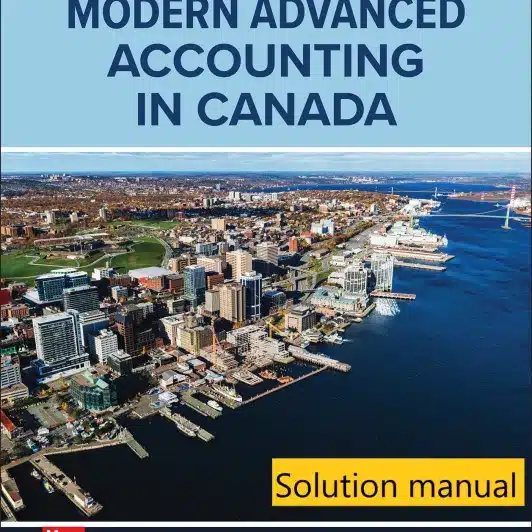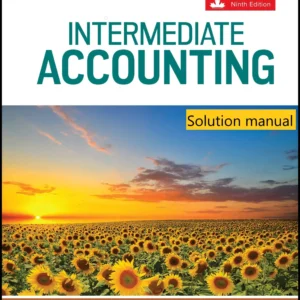Original price was: $39.99.$24.99Current price is: $24.99.
Solution manual for Modern Advanced Accounting In Canada 11th Edition By Darrell Herauf
![]()
Product ID: 0921200
For Contact: bookzon.shop@gmail.com
Description
Solution Manual for Modern Advanced Accounting in Canada, 11th Edition
By Darrell Herauf
![]()
Book Overview
The 11th Edition of Modern Advanced Accounting in Canada by Darrell Herauf is recognized as one of the most current and technically accurate resources for advanced accounting courses in Canada. This edition is trusted by both students and instructors for its detailed coverage of advanced accounting topics, especially in the Canadian context. The textbook has established itself as a reliable resource, offering comprehensive explanations and practical examples.
Fully compliant with International Financial Reporting Standards (IFRS), this edition covers essential topics such as business combinations, foreign currency transactions, and consolidated financial statements. Additionally, it includes the reporting requirements for private enterprises and not-for-profit organizations, which ensures it is applicable across various sectors. All financial statement extracts used in the text are taken from Canadian entities, making it highly relevant for students in Canada.
Herauf and Hilton’s emphasis on the direct approach to preparing consolidated financial statements and their focus on the building block development of consolidation fundamentals continue to be key strengths in this edition.
Key Features of the 11th Edition
1. IFRS Compliance and Global Standards
The 11th Edition is fully compliant with International Financial Reporting Standards (IFRS). This ensures that students are learning from a text that reflects the latest global standards in accounting, making them ready for international business environments.
-
Covers business combinations and foreign currency transactions under IFRS.
-
Includes reporting guidelines for private enterprises and not-for-profit organizations, addressing a wide range of real-world scenarios.
2. Canadian Context and Relevance
This edition is specifically tailored to Canadian accounting practices. All financial statement extracts are sourced from Canadian entities, making it a perfect fit for students pursuing accounting in Canada. The book covers both the public and private sector accounting standards, ensuring broad applicability.
-
Canadian examples reflect real business practices, enhancing the learning experience.
-
Private enterprises and not-for-profit organizations are given special focus, allowing students to understand diverse reporting requirements.
3. Emphasis on Consolidated Financial Statements
Herauf and Hilton’s approach to the preparation of consolidated financial statements continues to be a highlight of the textbook. The direct approach used in the book allows students to learn the basics of consolidations systematically, from basic principles to more complex topics.
-
Step-by-step guidance on preparing consolidated financial statements.
-
Building block development to help students understand consolidations at a foundational level.
4. Detailed Coverage of Key Accounting Topics
This edition expands on essential topics such as foreign currency transactions, business combinations, and intercompany profits. Students will find practical examples and applications, enhancing their understanding of the intricacies of advanced accounting.
-
Expanded sections on intercompany transactions and foreign operations.
-
Coverage of advanced experimental designs in accounting for business combinations and other complex financial issues.
Table of Contents
Chapter 1: Conceptual and Case Analysis Frameworks for Financial Reporting
Introduces conceptual frameworks used in financial reporting, providing students with an understanding of how to approach case analysis in accounting.
Chapter 2: Investments in Equity Securities
Explains the accounting for equity securities, covering topics like marketable securities and dividends.
Chapter 3: Business Combinations
Discusses the accounting methods used in business combinations, including the purchase method and goodwill calculations.
Chapter 4: Consolidation of Non–Wholly Owned Subsidiaries
Focuses on the challenges of consolidating subsidiaries that are not fully owned by the parent company, and how to handle minority interests.
Chapter 5: Consolidation Subsequent to Acquisition Date
Covers the process of post-acquisition consolidation, including merger-related adjustments and handling the subsidiary’s financials after the acquisition.
Chapter 6: Intercompany Inventory and Land Profits
Explains the elimination of intercompany profits from inventory and land transactions during consolidation.
Chapter 7: (A) Intercompany Profits in Depreciable Assets (B) Intercompany Bondholdings
A detailed exploration of intercompany profits in depreciable assets and the handling of bondholdings during the consolidation process.
Chapter 8: Consolidated Cash Flows and Changes in Ownership
Explores how to prepare consolidated cash flows and handle changes in ownership within the consolidated group.
Chapter 9: Other Consolidation Reporting Issues
Addresses additional consolidation reporting challenges such as non-controlling interests and adjustments during the consolidation process.
Chapter 10: Foreign Currency Transactions
Discusses how to account for foreign currency transactions, including conversion and the treatment of exchange rate differences.
Chapter 11: Translation and Consolidation of Foreign Operations
Covers the process of translating and consolidating foreign operations in the parent company’s financial statements.
Chapter 12: Accounting for Not-for-Profit and Public Sector Organizations
Focuses on the unique accounting requirements for not-for-profit organizations and public sector entities, highlighting the differences from for-profit accounting.
For more manual solutions, click here.






Professional service
Comprehensive and clear
Builds confidence
High quality
Suitable for all fields